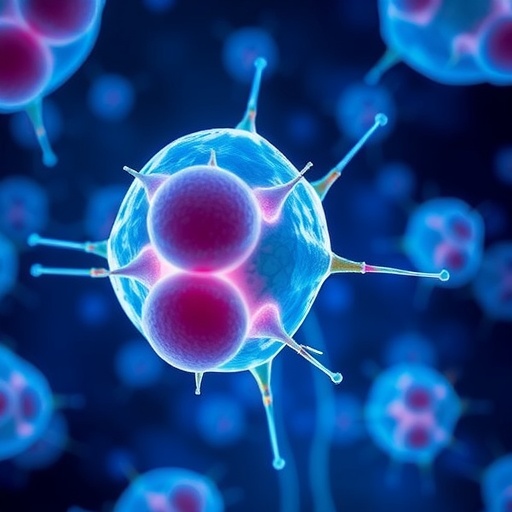In the relentless quest to tame malignancies such as acute myeloid leukemia (AML), the scientific community is confronting a formidable challenge: fully unraveling the intricacies of hematopoiesis, the process by which bone marrow generates the diverse array of blood cells essential for life. Despite substantial progress, especially in childhood cancer survival, certain blood malignancies continue to evade effective treatment, largely because our grasp of the cellular and molecular mechanisms driving blood cell development remains incomplete. A pioneering study from Cincinnati Children’s Hospital Medical Center now offers a transformative, integrative approach that could redefine our understanding of blood formation and open new pathways for targeted therapies.
The study harnesses the power of cutting-edge single-cell technologies and advanced computational methodologies to dissect the complexities of hematopoiesis at unprecedented resolution. By combining distinct analytical platforms—such as CITE-seq, TEA-seq, and InfinityFlow—the researchers constructed a comprehensive schematic that captures not only cell surface markers and transcriptomic landscapes but also chromatin accessibility and high-dimensional flow cytometric data. This synthesis of disparate modalities enables a multi-layered view of marrow progenitor cells, illuminating the dynamic and discrete states through which hematopoietic cells transit as they commit to specialized lineages.
Central to the study’s findings is a challenge to the long-standing “continuum” model of hematopoiesis. Contrary to the notion that progenitor cells gradually and smoothly transition along a developmental spectrum, the data instead reveal that cells occupy distinct “buckets” or discrete states characterized by specific transcriptional programs. These states serve as critical regulatory nodes, orchestrated by complex gene regulatory networks that modulate the progression from multipotency to lineage commitment. This refined model captures the stepwise and stable transitions underpinning differentiation, bringing into focus developmental crossroads where cellular fate is decisively determined.
A striking breakthrough in this research is the identification of a previously unappreciated set of rare progenitors designated as “MultiLin” cells. These cells are pivotal players in hematopoiesis, representing the last multipotent progenitor stage before irreversible lineage restriction. Unlike classical progenitor definitions, MultiLin cells possess a unique transcriptional and regulatory signature that equips them to give rise to a broad spectrum of mature blood cells, including erythroid, myeloid, eosinophil, basophil, and mast cells. Their capability to dynamically respond to physiological stresses such as parasitic infections highlights a sophisticated adaptive dimension of marrow biology that could be exploited therapeutically.
The researchers employed a novel computational strategy to unravel the gene regulatory networks controlling these states. By interrogating transcription factor (TF) activity with base-pair resolution within accessible chromatin regions, they deciphered how specific TFs influence extensive gene expression programs that drive cells toward lineage commitment or preservation of multipotency. This granular mapping of TF engagement provides an essential framework for understanding the molecular hierarchies guiding hematopoiesis, making it possible to predict and eventually manipulate these trajectories for clinical applications.
The significance of this multimodal integrative framework transcends hematopoiesis. According to Dr. H. Leighton “Lee” Grimes, the principal investigator, this approach could serve as a blueprint for elucidating developmental hierarchies across diverse complex tissues, including solid organs and tumors. The capacity to delineate discrete cell states and their regulatory underpinnings holds promise not only for stem cell biology but also for regenerative medicine and oncology, where cell fate determination is often disrupted.
Importantly, the expanded resolution and scope afforded by combining surface protein profiling, chromatin landscape analysis, and high-throughput flow cytometry enable an unprecedented ability to isolate and characterize rare cell populations that traditional methods might overlook. Such precision paves the way for targeted isolation of therapeutically relevant progenitors or malignant subsets, facilitating the development of interventions that are fine-tuned to specific cellular contexts and gene programs.
Moving forward, one of the critical steps outlined by the research team is the translation of insights gained from murine models to human biology. While murine hematopoiesis has served as a foundational system for decades, the adaptation of this unified single-cell multi-omics approach to human bone marrow samples is essential for clinically relevant discoveries. Achieving this will demand overcoming challenges related to tissue accessibility, variability, and scaling but holds transformative potential for personalized medicine.
The implications of this research extend into stem cell engineering, where understanding and recreating natural developmental programs in vitro has been a long-standing goal. This discrete state model sets the stage for more accurately recapitulating hematopoietic differentiation pathways, thereby improving the efficiency and fidelity of laboratory-grown blood cells. Such advances could revolutionize treatments for congenital blood disorders, increase the availability of transfusable cells, and bolster cell-based immunotherapies.
Furthermore, the integrative approach underscores the utility of applying comprehensive computational tools to biological data—a necessity when dissecting complex systems with overlapping and dynamic regulatory layers. By combining dimensionality reduction techniques, imputation algorithms, and high-resolution TF binding analysis, the study provides a template for future research aiming to decode cellular heterogeneity and plasticity, whether in developmental biology or disease contexts.
The research was supported by grants from the National Institutes of Health and benefitted from collaboration with Cytek Biosciences, which provided advanced cytometry services. The multi-institutional team exemplifies the kind of interdisciplinary effort—melding bioinformatics, molecular biology, and clinical expertise—required to solve pressing biomedical puzzles.
This study pulls back the curtain on the cellular choreography of blood formation with a clarity and detail that were previously unreachable. It not only refines our conceptual frameworks in hematopoiesis but also offers tangible technological and biological tools to accelerate the development of next-generation cancer treatments and regenerative therapies. By exposing the discrete states that govern stem cell hierarchies, this novel framework heralds a new chapter in understanding life’s fundamental processes and translates them into medical breakthroughs.
Subject of Research: Cells
Article Title: A unified multimodal single-cell framework reveals a discrete state model of hematopoiesis in mice
News Publication Date: 22-Oct-2025
Web References:
https://www.nature.com/articles/s41590-025-02307-3
https://altanalyze.org/MarrowAtlas/
Image Credits: Cincinnati Children’s
Keywords: Health and medicine, Biomedical engineering, Cell biology, Computational biology, Developmental biology, Immunology
Tags: acute myeloid leukemia researchadvanced computational methodologiesbone marrow functioncellular development in hematopoiesischildhood cancer treatmentsCITE-seq and TEA-seq applicationshematopoiesis mechanismsinnovative approaches in cancer researchmarrow progenitor cells analysismulti-dimensional analysis in biologysingle-cell technologies in biologytargeted therapies for blood malignancies





